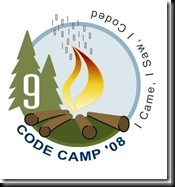Starting one week from today, April 5th and 6th 2008 is the 9th semi-annual Code Camp at the Microsoft New England District office in Waltham, MA. A code camp is something like a mini-conference, held on a weekend, and it's free.
That's right - it's free.
And why am I blogging about an event that's around 300 miles away from me? Because I'm going to be presenting three sessions on SQL Server Integration Services, that's why! I am scheduled to deliver these three exciting SSIS sessions:
Jumping Into the ETL Deep End with SQL Server Integration Services
If you’re a developer, you often run into situations where you need to get data from point A to point B, and often need to massage it along the way. Odds are you’ve seen the SSIS tools, but like many DBAs and developers you weren’t quite sure where to begin. If this sounds familiar, then this is the session for you. In this session you’ll learn what SSIS can do, how to make it do what it does, and what tools to use to make it work its magic. We’ll look at package development and deployment, and when the session is done you’ll be ready to build and deploy SSIS packages with confidence.
SQL Server Integration Services Development Best Practices
Are you tired of feeling like you’re making the same mistakes over and over again? Would you like to have a roadmap that outlines the pitfalls you’re likely to encounter when building ETL solutions with SSIS? Then this session is for you! In this session you’ll learn how to get the most of the SSIS tools and platform through a set of SSIS development best practices from a battle-scarred database and BI consultant who has survived the rough projects and lived to tell the tale.
SQL Server Integration Services Deployment Best Practices
You've built a set of SSIS packages to populate your data warehouse, and everything works great on your development environment - but what next? SSIS has a great set of tools, but when it comes to preparing for and executing a seamless deployment from development into test and finally into production, it's not always obvious what tools to use or how to best use them. In this session you'll learn how to prepare for and execute a seamless deployment of complex ETL solutions through a repeatable, testable process for both SQL Server 2005 and SQL Server 2008. If you're tired of saying "but it worked on my machine!" then this is one session you can't afford to miss.
And not only am I scheduled to present these three sessions, there are over 60 different sessions on topics ranging from SQL Server to Windows Communication Foundation to SilverLight to Visual Studio to BizTalk. It looks like this will be a fantastic event!
Fantastic for the attendees, anyway. ;-)
Did you notice how I was being especially careful to say "I'm scheduled to present three sessions" instead of "I'm presenting three sessions?" There's a reason for that. The "Jumping Into the ETL Deep End with SQL Server Integration Services" session is scheduled for 10:35 Saturday morning, and there is a decent chance that I will not be able to reach Waltham in time. I'm going to be out on the west coast all next week, and my flight home is scheduled to arrive around midnight Friday night. Since it's a four hour drive to Waltham under ideal circumstances, there's a pretty good chance that I will actually deliver two SSIS sessions and not all three.
But don't let this stop you! There are still around 75 attendee slots still open (out of the available 500) so sign up now if you haven't already. And I'll see you there!
Update: The fantastic organizers of the Code Camp (thanks, Chris and Chris!) have reworked the schedule to accommodate my travel restrictions, so all three sessions should go as planned. Here are the updated times for my three sessions:
Sat 15:25-16:40 - Jumping Into the ETL Deep End with SQL Server Integration Services
Sat 16:50-18:05 - SQL Server Integration Services Development Best Practices
Sun 12:30-13:45 - SQL Server Integration Services Deployment Best Practices
